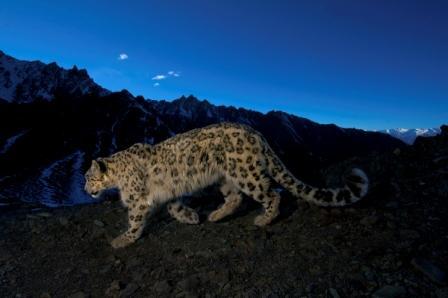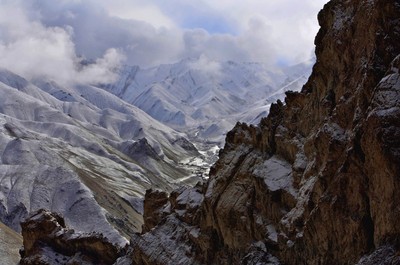
By Steve Winter
The snow leopard is one of the most elusive cats in the world. As few as 3,500 of them may still roam the harsh, forbidding mountains of Central Asia. No one knows for sure.
In 1999 my editor at National Geographic Magazine circulated an email asking for ideas on our "dream assignment". I remembered how my life had been touched when years before I had read George Schaller's "Stones of Silence" and Peter Matthiessen's "The Snow Leopard".
I chose snow leopards - and so began the quest. But how do you produce a story about a animal you may never see? Our answer: a six-month expedition into the Indian Himalayas armed with 14 "camera traps." When a snow leopard walked by it would break the infrared beam, fire the camera and take its own picture.
High Camp
Our seven-person team trekked into Hemis High Altitude National Park in mid-January, with packhorses ferrying our 60+ bags into base camp. I'm a steamy jungle kind of guy, so the first night in my tent when temperatures plummeted to 40-below was a bit of a shock. I'd dragged propane tent heaters with me from the States, but at 14,000 feet there wasn't enough oxygen to keep them burning. The cook gave me a bottle filled with boiling water to put in my sleeping bag, but by morning it was a solid block of ice. Welcome to winter in the Himalayas.
Our camp was nestled in a valley surrounded by towering peaks. Visually it looks like you're on the moon. Day after day, we climbed those steep, rocky peaks hunting for clues that snow leopards were in the area, looking for places they'd marked territory or left a scented invitation for a possible mate.
We discovered a trail with a series of markings: fresh tracks, patches of fur where a cat had rubbed on a rock, places where it had raked the ground with scratch marks or sprayed its scent. If it was a photogenic location, I would set one of my 14 camera traps. I'd compose the frame, light the scene with three flashes -- much like a movie set -- and hope that the actor would step onstage.
Then the waiting game began. Would the cat walk by? Would it be shocked by the flashes?
Getting the Shot
In three days we got our first pictures, which gave us hope. But it was completely random. One camera captured just one snow leopard image in six months -- one of the best pictures. Another produced just two pictures. With no pictures for weeks on some cameras, and changing weather, we moved the cameras again and again, ultimately setting them up in 45 different locations.

Conservation
Snow leopards are still threatened by their only predator -- humans. Many cats are shot or poisoned by herders in retaliation for killing their goats, sheep, or yaks, the livestock they rely on for survival in a harsh environment. It's a problem across all 12 Central Asian countries where snow leopards live. The cats eat more livestock as their main prey -- wild sheep and goats -- disappear, hunted by local people or starved out by livestock. And then there's the poachers who kill the cats for their luxurious pelts (worth at least $600 on the black market) or their bones, which are still used in traditional Asian medicine (the bones can fetch a whopping $5,000 or more)!
Community-based conservation programs that put money in the pockets of local people are making a difference. Panthera, the world's largest big cat conservation organization, is funding programs to sell local handicrafts in the U.S., vaccinate livestock herds, and bring foreign trekkers to stay in villager's homes -- as long as the villagers sign a contract that they won't kill snow leopards.
Because the cats live in such a forbidding environment -- and are so rarely seen by humans -- there are huge holes in our knowledge of this mysterious cat. Like what their range is, how many kittens are born in the wild, what they do when they meet up in those mountains. Less is known about the snow leopard than any of the big cats, but Panthera has recently launched the first-ever range-wide research and conservation project for this species.
Each of my images of this ghostly cat was a gift, a collaboration between the snow leopard, local naturalists and myself.
Learn more about Panthera's Snow Leopard Conservation Program
About Steve Winter
Internationally renowned, award winning wildlife photographer and explorer Steve Winter has been named Director of Media at Panthera, the premier global organization dedicated to assuring the future of the world's wild cats and their landscapes.
Winter's appointment comes on the heels of his Wildlife Photographer of the Year Award from the BBC and the Museum of Natural History in London, which he received in November for his photographs of the elusive snow leopard. Most recently, Winter was honored with first prize for best nature story for his snow leopard images during the 52nd Annual World Press Photo Awards in Amsterdam- the world's premier photojournalism awards.



